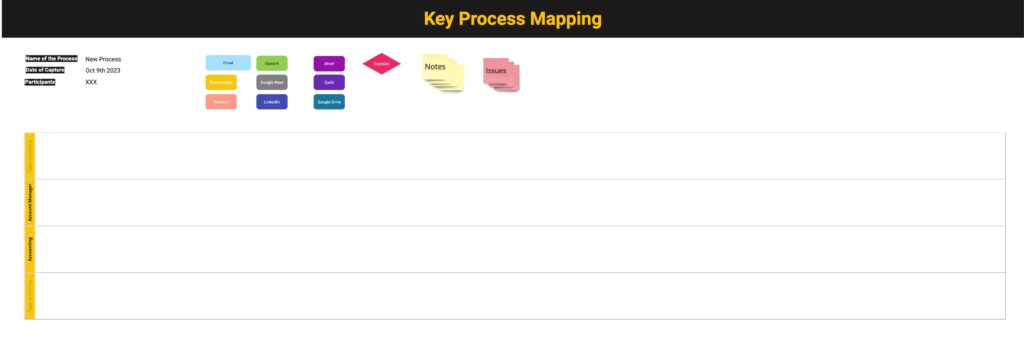As your service-business grows, you’re delegating more and more tasks. Your team needs to follow processes to deliver work efficiently and to ensure a great client experience.
Over time, naturally things will stop working. The processes that allowed your team to handle 10 client accounts likely won’t support 50 client accounts.
Time to improve processes. In this article, I’ll describe a framework to improve processes in your service business.
First, let’s have a look at what process improvement is and why it’s special (and hard) in service businesses.
Then we’ll look at the steps for process improvement in service businesses:
- Identify the highest priority processes
- Understand the status quo
- Find the root causes of issues
- Design solutions
- Implement, train and manage change
- Continuous improvement
What is process improvement
Process improvement are activities that aim at improving the way your organization executes recurring tasks.
Process improvement can take many shapes or forms. It often happens during or after extensive company growth, when operations need to be consolidated.
Typical signs that your service business needs process improvement:
- Decline in client experience
- Tasks go uncompleted
- Low quality of deliverables
- Low profitability
- Long turnaround times
- Overstaffed team
- Ad-hoc fixes and firefighting
- High involvement of leadership in operations
- Low morale and ambiguous responsibilities
If you’re experiencing any of the above, you might want to have a look at your processes.
Why improving processes in service is hard
The nature of service-businesses poses some challenges on process improvement efforts.
Clients are part of the process
By definition, a service-business’ value is generated with the client (as opposed to a product, where the value is generated before a customer is involved).
This means that you can’t stubbornly improve processes for high efficiency, but always need to account for the great unknown, your client.
You’re not in control of your client’s behavior, which creates a natural limit to the level of efficiency in client facing processes.
To give an example, clients will respond slowly to requests, don’t give feedback on deliverables or submit incomplete briefings or information.
All your processes, and thus your improvement efforts, need to account for that low level of predictability.
Client experience matters
When optimizing processes, you always need to account for the client experience. What does it feel like working with you?
This means that often you need to take a more complicated and inefficient approach to maintain a great experience.
People working for people
Most service businesses are people heavy. It’s people delivering value for people.
So not only do you have to account for the client’s behavior, but also need to acknowledge the human factor of your own operations.
Limited data and low transparency
Given the human-to-human nature, you typically have little data about your processes and quality. The data you have will often be qualitative instead of quantitative, think client feedback.
In addition, as you can’t be part of all conversations happening in your organization, you have limited transparency about what’s actually going on.
With these difficulties in mind, let’s look at how you can still improve processes in your service business.
Get help improving your processes. Book a free discovery call.
Identify the highest priority processes
The starting point for any process improvement is identifying which processes to improve.
In most cases you will have a strong feeling about which part of your operations need work.
If that’s not the case, here’s a simple process to identify the highest-value processes to work on:
- Map all your processes. The value chain is a great tool to structure this collection.
- Select the most promising candidates from that list and evaluate how often the process is being executed, how big the current pain is and how high the value is this process adds to your clients (and ultimately to your business)
- The result of this exercise will tell you the sequence of processes to tackle.
- If there’s a process that’s underlying and, when improved, would fix other problems in other processes, that’s the process to start with.
Understand the status quo
The basis for improving a process is understanding and agreeing on the status quo of the process.
Mapping the process
In the first step, you want to map the process. This means documenting how it’s currently executed in visual form. An excellent tool to do this is a swimlane diagram.
For a detailed guide on how to use the swimlane diagram for process mapping, check out this article.

Each lane represents a role inside of your business.
What’s special about service businesses: Your client, too, will have a lane. This way, you can easily create an overview of touch points, feedback and approval loops and the like.
Map the process step by step, and color code the boxes you use to represent the tool that’s being used in this step.
As you go, use yellow sticky notes for comments, and red sticky notes for things that don’t work well and need improvement.
Collecting all issues
Once you’re done, you’ll have a swimlane diagram with a number of red sticky notes. Extract them and collect them in a separate space. These are the issues you’re trying to fix.
Find the root causes of issues
The next step is to get to the root cause of the issue. You want to get to the very bottom of the issue, and don’t stop at the symptoms.
Check out the five best root cause analysis tools here.
Given that qualitative nature of issues in service, a good starting point for your root cause analysis is the 5 Whys Methodology.
It’s simple. Ask “Why” five times and you’ll arrive at the root cause of the problem.
An example.
Issue: Client feedback delays service delivery. Clients give feedback on the next month’s marketing calendar late, so we are already behind schedule when we start implementing.
1st Why? They don’t respond in the timeframe we need.
2nd Why? They don’t have the capacity to give feedback within the timeframe.
3rd Why? They don’t have time allocated to give feedback at the time we need them to.
4th Why? They don’t know when the feedback will be required.
5th Why? We don’t communicate timeline for feedback in the kickoff or on our monthly calls.
The last answer is one root cause of the issue.
Be aware that there might be multiple root causes. Answering the first why differently will lead to another root cause.
Example:
1st Why? The feedback is either incomplete or superficial.
2nd Why? Clients don’t have clear guidelines from us to know what their feedback should look like.
Repeat the 5 Whys until you can’t come up with more root causes.
Prioritize issues and design solutions
With all your process issues analyzed, you can start prioritizing them.
Prioritizing issues
To do that, assess two dimensions:
- What’s your level of control over the issue? Everything that involves the client is harder to fix than what you do internally.
- How much value would a solution provide?
Focus on the items that you have high control over, and that would provide high value. Following those, tackle the ones that provide high value, and you have low control.
If there are some quick wins in the low value, high control area, just take them as well.
Design solutions
It often feels like solution design is where the magic happens. It’s not. Rather, solution design is fairly straightforward if you’ve done your homework.
An issue thoroughly analyzed and broken down into its underlying components is an issue as good as solved. The solution in many cases will be rather obvious. The key here is to not jump to solution design too fast.
A few best practices when designing a solution.
- Keep client experience in mind. If you want to build a white glove service for corporate clients, an automated onboarding process with no human interaction will not be a great idea. Even though it might fix some operational issues.
- Changes should ideally be a Pareto improvement. You improve something (your operations), while the client should be at least as happy as before. Ideally, even happier.
- Involve your team in the design phase. The more they have a say in what the future looks like, the easier it will be to get them to adopt the changes.
- Keep complexity in check. You can solve all possible problems, but this will create a process monster. Rather, focus on the Pareto 20% of cases that make up 80% of the business.

Implement, train and manage change
Next, you need to make sure that the processes you’ve updated are being used.
Implementation
Think through your operational setup thoroughly and update all things that are related to the process improvement. This can include:
- Your task management tool and how it’s set up.
- Communication structure and job descriptions
- Templates you use
- KPIs you measure
Tip: The first time you run through a process improvement, keep track of all the things you had to update. Save this list as a checklist, so the next time you adapt processes, you know where to screen for necessary updates.
Communicating changes to clients
In many cases, changes in process will affect how you interact with your clients. You might opt to trial a new process with an “easy” client.
Once you move into rollout, you need to communicate changes that are relevant to the client. Let them know how this change will benefit them (ideally it should).
Training and change management
An updated process essentially means that your team will need to change the way they do things. And while everyone might agree to the changes on paper, making this change happen sustainably will take time.
When you (or someone in your team) train your employees on the process update, be sure to cover two things:
- Be very clear on the “head” level. Paint a clear picture of why the new process is better, what exactly the changes are that the team needs to pay attention to and what new tools/ updated practices will be used.
- Find a way to also speak to the “heart”, adding an emotional component to the training. The team should not only know how the process improvement works, but should feel why it’s necessary and how it will benefit them (short and long term). If the new process is less work, great. If you don’t have these obvious wins for the team, you can always argue with the long-term success and growth potential of the business, ultimately guaranteeing your employees’ livelihood.
In addition, accept that change is a process, not a point in time. Regular check-ins on how the new process is working, collecting issues and being there for the team in case of questions or uncertainties helps.
For example, when we implement a new task management system, we hold weekly user meetings for a couple of weeks or months, to have an open channel of communication. Over time, people will get used to anything. But expect things to take time.
Continuous improvement
Once the process is improved, the journey starts from the beginning. In operations, there’s no perfection, just improvement.
Set up a simple continuous improvement framework that allows you to continuously improve all processes inside your organization.
The simplest version of this is this:
- Build a place for people to centrally collect potential improvements as they identify them.
- Every month (bi-weekly, weekly, depending on your team and nature of your business), meet to discuss the new items and prioritize them.
- Assign the highest-priority items to someone in your team, and set a due date for completion.
- Follow up on assigned items.
Following this outline will ensure that your process improvement efforts are successful.